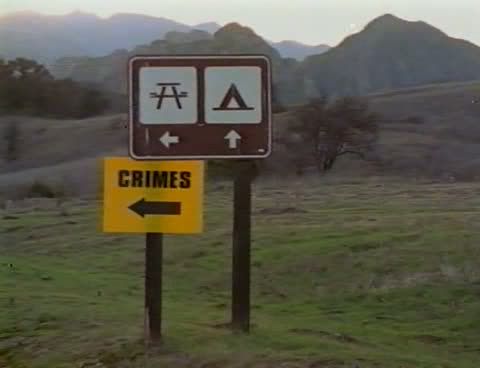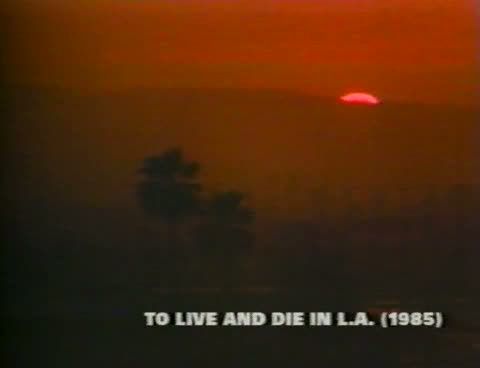
Thom Andersen's magnum opus, Los Angeles Plays Itself, is a thoughtful, methodical consideration of Los Angeles as a city of the movies — not only as the city where the movies are made, but the city that appears onscreen in those movies, the most photographed city in the world if not always the most photogenic. It's a fantastic, wide-ranging work of criticism, a film that hones in on specific moments, specific shots, from countless movies, expanding upon isolated glimpses of Los Angeles as it is, as it was, and as it only ever could be onscreen. It's an examination of the relationship between the Los Angeles of the movies and the Los Angeles of reality, and of the the many different ways in which this city has been represented in the cinema. It's a work of film criticism that delves into the implications of various types of cinematic representation, but it also deals with history, with the social context in which the movies are made and in which a city changes, with architecture, with race and class, with the nature of urban identity and the specific image that Los Angeles projects of itself.
It's always Los Angeles for Andersen, never L.A., as he lambastes the shortening of the city's name as a mark of disrespect and laziness. Notably, he takes his own film's name from a 70s gay porn flick called L.A. Plays Itself, which he characterizes as a trip from the almost-rural idylls of Los Angeles' outskirts to the urban blight of its center: as the locale gets more urban in the film, he says, the sex gets rougher. Andersen's expansion of that title is a way of restoring the city's full name, rescuing it from the curse of shorthand. Towards the beginning of his film, a montage of movie titles that start with "L.A." suggests that this diminutive nickname is one source of the movies' reduction and simplification of Los Angeles, a sign that the Los Angeles that appears in the movies only flirts with the reality of the city.
Andersen's film examines, in three parts — the city as background, as character, and as subject — the role of Los Angeles in the history of the movies. His film is a collage of scenes from numerous movies, from old Hollywood classics and noirs to more modern blockbusters and disaster movies to the avant-garde work of Warhol and Deren. He mixes in a smattering of his own footage, juxtaposing various city landmarks from the movies with their modern incarnations, along with newspaper headlines that bring the city's real history into contact with its movie counterparts, particularly when talking about the true stories that provided the inspirations for Chinatown and L.A. Confidential. Andersen couples these borrowed and recontextualized images with a lucid, sophisticated commentary (read by Encke King, in a similar flat tone to the one employed by Dean Stockwell in Andersen's earlier Eadweard Muybridge, Zoopraxographer) that pulls out the subtext from all these images of the city, fitting each movie, each image, neatly into Andersen's critical framework. Andersen is credited with "research/text/production" rather than as the director, an acknowledgment of his special role as an archive-trawler and critic. What he's doing here is assembling a critical essay where his evidence, his examples, are readily available as onscreen footnotes to the text.

One of Andersen's central ideas here is the gap between reality and screen representation. He identifies many ways in which Los Angeles on screen differs from Los Angeles as an actual city, tracing the city's cinematic history from its early days, when in its anonymity it often stood in for Chicago or New York or any number of other cities, to the much more specific visions of later years. There's Los Angeles as a site of disaster movie destruction, the home town that moviemakers seem to take special delight in tearing apart. There's Los Angeles as a city of cops, and Andersen's deconstruction of Dragnet as a fascist version of the precise, minimalist aesthetics of Ozu and Bresson is especially potent. And also very funny. Andersen has a sharp, biting sense of humor, and he mingles seemingly genuine admiration for Dragnet's robotic technical precision with contempt for its exaltation of an "ideal" cop who tramples all over the pathetic, kooky, corrupt people he encounters in the course of his job. It's similarly hilarious when Andersen uses a shot of Charles Bronson literally exploding a bad guy as the punchline to a sequence in which Andersen laments the movie convention of staging chase scenes that leap from locale to locale with little regard for physical reality: "silly geography makes silly movies," the voiceover says, and with Bronson as evidence it's hard to argue.
That's a throwaway gag, though, and Andersen's critical commentary ultimately has much more serious aims. One of his most interesting insights is the idea that Los Angeles, as presented in the movies, is a city of perpetual nostalgia for a time that never was. "At any time in its history, Los Angeles was always a better place a long time ago than in the present," the narration says, speaking especially about movies like Chinatown, Blade Runner and L.A. Confidential. It's Andersen's contention that movies about Los Angeles are often period movies, rarely movies about the present, at least not in the modern era. He takes as one telling example the rather startling absence of the Watts riots from most films; it was only long after the riots had faded a bit that movies could portray the events, Andersen says, and then only with a comforting and ironic use of banal 60s oldies tunes to place the events safely and securely in the past. There seems to be widespread discomfort in really engaging with Los Angeles' present, even in the futuristic Blade Runner, which presents a dystopian Los Angeles that is actually, perversely, rather attractive, a glossily beautiful if frightening vision of the future that Andersen contrasts against the much plainer, uglier possibilities that are likely to shape the real Los Angeles of the future.
Architecture is another of Andersen's big concerns. He teases out how the modernist architecture of the 20s and 30s — and by extension the utopian ideals often motivating the movement — have in the cinema been co-opted as a signifier of suave evil, to the point that a modernist villa in the hills overlooking Los Angeles, with the inevitable large glass panels and angled lines, is sure to provide a base for some corrupt businessman or gangster, a pornographer or a drug dealer, a cop on the take or a gang of kidnappers. In contrast, he traces the origin of the Spanish revival style's status as a signifier of bourgeois pretensions to Double Indemnity, and to screenwriter Billy Wilder's distaste for the style's fake appropriation of the past and of another culture. This is perhaps the film's most fascinating current, this emphasis on how different types of buildings, and different neighborhoods, provide cinematic shorthand for different types of people. Later, Andersen will unearth the history of the Bunker Hill neighborhood, from its status as a comfortable middle class suburb to its descent into seedy film noir environs in Kiss Me Deadly to its 70s desolation presaging its complete destruction and reconstruction as a generic urban area, with little trace remaining of its distinctive past. The only reminders of the old Bunker Hill are in the movies, in the various onscreen incarnations of the neighborhood that mirrored, over the years, the changing nature of the neighborhood. For Andersen, there's a documentary quality to even the most fictional of movies, a tendency he'll explore again in a sequence that chronicles the evolution of gas station style from the 40s to the 70s.
Andersen's central thesis — the gap between reality and Hollywood fictions — could easily result in facile conclusions about how fake the movies are. Sometimes, in his more tossed-off observations, there's a hint of this, as when Andersen complains that Robert DeNiro's book store employee girlfriend in Heat could never afford her gorgeous hillside house with a spectacular view of the city proper. But such observations, though bordering on the banal in isolation, are tied together in Andersen's later emphasis on the socioeconomic subtexts and political blind spots in Hollywood depictions of Los Angeles. A big part of it is white male privilege, which Andersen brings up by way of Woody Allen, a tourist in Los Angeles whose famous putdowns of the city from Annie Hall obviously get Andersen's back up. "I don't want to live in a city where the only cultural advantage is that you can make a right turn on a red light," Woody says, and it's easy to see why Andersen, who loves Los Angeles so intensely, is put off. (Sorry, it's still funny anyway.)

The film ends with a consideration of an alternate cinema of Los Angeles, the discovery of a kind of Californian neorealism by black filmmakers like Charles Burnett, Haile Gerima and Billy Woodberry in the 70s and 80s. Andersen's sudden turn into these movies at the end of his cinematic history of Los Angeles suggests that for all of the movies that purport to show Los Angeles from various angles and perspectives, so few of them really focus on the people of the city outside of the privileged milieus of the upper class, the police, the movie industry itself. Los Angeles might be the most photographed city in the world, Andersen suggests, but large portions of its population are very much under-photographed, a point he underscores by comparing the 70s and 80s black independent films to various Hollywood comedies and melodramas in which privileged white people shuffle around Los Angeles without ever encountering much if any sign of the city's ethnic and socioeconomic diversity. Andersen's commentary closes on a note of irony, accompanying images from Woodberry's Bless Their Little Hearts of a closed tire factory. Once people could take tours of the factory to see how tires were made, the narrator deadpans, just as now they can take tours of movie studios to see how movies are made.
The voiceover suggests a progression from a concrete product — and concrete jobs for working class, ordinary people who struggle to provide for their families — to the abstract dream factories of Hollywood, an image that has colonized the popular perception of Los Angeles, largely through the self-projection of the movies, in which the city and its people are inevitably dwarfed by the movie industry. Just as the movies have largely created and reproduced an artificial image of Los Angeles with little relation to the lives of most of its people, those same people, denied representation on movie screens, are increasingly marginalized from real life as well, their jobs taken away, their neighborhoods demolished and replaced by skyscrapers. In the end, Andersen's criticism is socially and politically oriented as much as it is rooted in cinematic or aesthetic concerns. His film, in documenting what films about Los Angeles show, is also very conscious of what they, generally speaking, do not show.







0Awesome Comments!